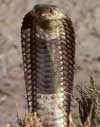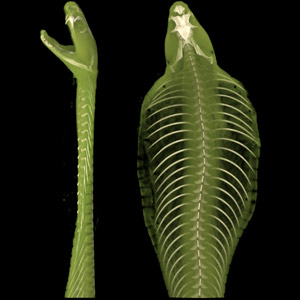 The Egyptian cobra (Naja haje) is one of the most widespread, largest, and best known of the cobras. Reaching lengths of over 2.5 meters, these are thick-bodied snakes (for cobras) with rather elongate slender tails. Many of the recognized subspecies have distinctive color patterns, but the most common color morph is a nearly uniformly dark brown dorsal surface with lighter ventral scales. Naja haje lacks the prominent dorsal “eye spot” seen in other cobras, but the ventral surface of the neck frequently supports a distinctive dark band. The Egyptian cobra (Naja haje) is one of the most widespread, largest, and best known of the cobras. Reaching lengths of over 2.5 meters, these are thick-bodied snakes (for cobras) with rather elongate slender tails. Many of the recognized subspecies have distinctive color patterns, but the most common color morph is a nearly uniformly dark brown dorsal surface with lighter ventral scales. Naja haje lacks the prominent dorsal “eye spot” seen in other cobras, but the ventral surface of the neck frequently supports a distinctive dark band.
This species ranges through most of Central and Northern Africa, as well as much of the Middle East. While not a true desert snake, it has a wide habitat range from semi-desert to human agriculture. The Egyptian cobra is commonly found in surprising numbers around rural, and sometimes even urban, human habitation. This may be reflective of the fact that Naja haje is a true feeding generalist (consuming a wide range of vertebrate prey, including other snakes) with what is generally described as a voracious appetite. All too commonly this brings these large elapids, which are nocturnal by nature, into close contact with humans; they frequently enter human dwellings or are tread upon outdoors at night. The neurotoxic venom of Naja haje is one of the most potent of all the cobra venoms; bites from this species are one of the leading causes of snakebite mortality worldwide.
These snakes have a rather “charmed” position in folklore and human sociology. It is often argued that the “asp” that Cleopatra reputedly used to end her life was actually an Egyptian cobra. In modern times these snakes are a mainstay of the African and Middle Eastern snake charming industry. Like other cobras, Naja haje has large eyes and is very responsive to visual stimuli. A flute, scarf, or earthen jug waved in front of an Egyptian cobra will almost always evoke a fairly stereotypic defensive display in which the anterior quarter of the body is held vertically and approximately the first 20 ribs are rotated dorsally. This dorsal rotation of the ribs markedly expands the neck region of the cobra into what is commonly called the hood, while compressing the animal dorso-ventrally (as in the specimen here). With careful stimulation, cobras can be induced to hold this defensive posture (including sham strikes) for hours. The snake charmer’s ability to handle these visually stunning animals for the entertainment of paying tourists is a significant economic aspect of many rural villages. Increasingly popular among snake keepers in the West, the Egyptian cobra is now frequently bred in captivity and readily available commercially.

About the Species
This specimen was preserved with the hood erect. It was made available to the University of Texas High-Resolution X-ray CT Facility for scanning by Dr. Kenneth Kardong of Washington State University and Dr. Bruce Young of Washburn University. Funding for scanning was provided by Dr. Kardong. Funding for image processing was provided by a National Science Foundation Digital Libraries Initiative grant to Dr. Timothy Rowe of The University of Texas at Austin.

About this Specimen
The specimen was scanned by Matthew Colbert on 30 October 2007 along the coronal axis for a total of 976 slices. Each slice is 0.1807 mm thick, with an interslice spacing of 0.1807 mm and a field of reconstruction of 83 mm.

About the
Scan
Literature
Broadley, D.G. 1968. A review of the African cobras of the genus Naja (Serpentes: Elapinae). Arnoldia Rhod. 3:1-14.
Haagner, G.V. 1993. Life history notes. Elapidae: Naja haje annulifera – diet. J. Herpetol. Assoc. Afr. 42:39-40.
Schleich, H.H., W. Kastle, and K. Kabisch. 1996. Amphibians and reptiles of North Africa. Koeltz, Koenigstein.
Sprawls, S. and B. Branch. 1995. The dangerous snakes of Africa. Blanford, London.
Links
Naja haje page on Kingsnake.com
Elapidae page on The Reptile Database

Literature
& Links
Front page image.
|  |

Additional
Imagery
|









